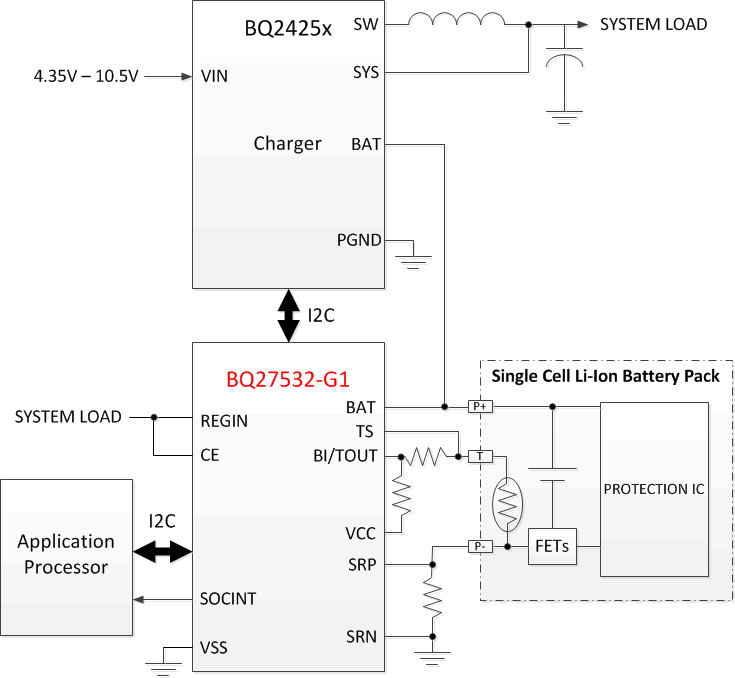SLUSBU6B September 2014 – January 2016
PRODUCTION DATA.
- 1 Features
- 2 Applications
- 3 Description
- 4 Revision History
- 5 Pin Configuration and Functions
-
6 Specifications
- 6.1 Absolute Maximum Ratings
- 6.2 ESD Ratings
- 6.3 Recommended Operating Conditions
- 6.4 Thermal Information
- 6.5 Electrical Characteristics: Supply Current
- 6.6 Digital Input and Output DC Electrical Characteristics
- 6.7 Power-on Reset
- 6.8 2.5-V LDO Regulator
- 6.9 Internal Clock Oscillators
- 6.10 ADC (Temperature and Cell Measurement) Characteristics
- 6.11 Integrating ADC (Coulomb Counter) Characteristics
- 6.12 Data Flash Memory Characteristics
- 6.13 I2C-compatible Interface Communication Timing Requirements
- 6.14 Typical Characteristics
- 7 Detailed Description
- 8 Application and Implementation
- 9 Power Supply Recommendations
- 10Layout
- 11Device and Documentation Support
- 12Mechanical, Packaging, and Orderable Information
Package Options
Mechanical Data (Package|Pins)
- YZF|15
Thermal pad, mechanical data (Package|Pins)
Orderable Information
1 Features
- Battery Fuel Gauge and Charger Controller for 1-Cell Li-Ion Applications up to 14,500-mAh Capacity
- Resides on System Main Board
- Battery Fuel Gauge Based on Patented Impedance
Track™ Technology
- Models the Battery Discharge Curve for Accurate Remaining Capacity Predictions
- Automatically Adjusts for Battery Aging, Battery Self-Discharge, and Temperature and Rate Inefficiencies
- Low-value Sense Resistor (5 to 20 mΩ)
- Battery Charger Controller With Customizable Charge Profiles
- Configurable Charge Voltage and Current Based on Temperature
- Optional State-of-Health (SoH) and Multi-Level Based Charge Profiles
- Host-free Autonomous Battery Management System
- Reduced Software Overhead Allows for Easy Portability Across Platforms and Shorter OEM Design Cycles
- Higher Safety and Security
- Runtime Improvements
- Longer Battery Runtime Leveraging Impedance Track™ Technology
- Tighter Accuracy Controls for Charger Termination
- Improved Recharge Thresholds
- Intelligent Charging – Customized and Adaptive Charging Profiles
- Charger Control Based on SoH
- Temperature Level Charging (TLC)
- Stand-alone Battery Charger Controller for bq2425x Single-Cell Switch-mode Battery Charger
- 400-kHz I2C™ Interface for Connection to System Microcontroller Port
2 Applications
3 Description
The bq27532-G1 system-side, Li-Ion battery management unit is a microcontroller peripheral that provides Impedance Track™ fuel gauging and charging control for single-cell Li-Ion battery packs. The fuel gauge requires little system microcontroller firmware development. Together with bq2425x single-cell switch-mode charger, the fuel gauge manages an embedded battery (non-removable) or a removable battery pack.
The fuel gauge uses the patented Impedance Track algorithm for fuel gauging, and provides information, such as remaining battery capacity (mAh), state-of-charge (%), runtime-to-empty (minimum), battery voltage (mV), temperature (°C), and SoH (%).
Battery fuel gauging with the device requires only PACK+ (P+), PACK– (P–), and thermistor (T) connections to a removable battery pack or embedded battery circuit. The 15-pin NanoFree™ (CSP) package has dimensions of 2.61 mm × 1.96 mm with 0.5-mm lead pitch. It is ideal for space-constrained applications.
Device Information(1)
| PART NUMBER | PACKAGE | BODY SIZE (NOM) |
|---|---|---|
| bq27532-G1 | CSP (15) | 2.61 mm × 1.96 mm |
- For all available packages, see the orderable addendum at the end of the data sheet.
Simplified Schematic
